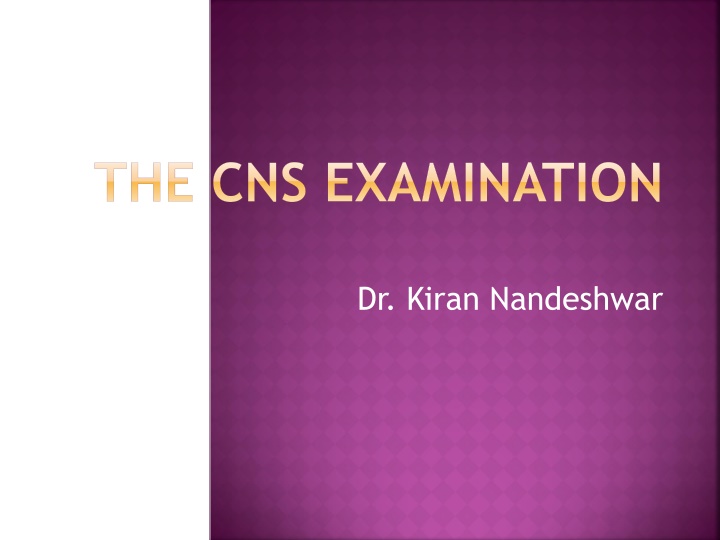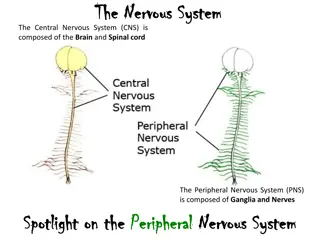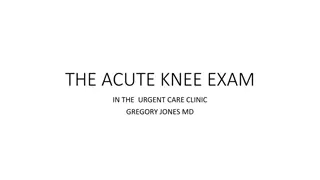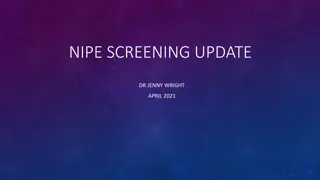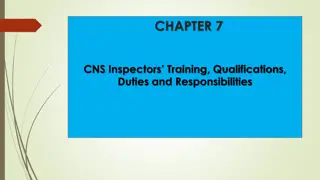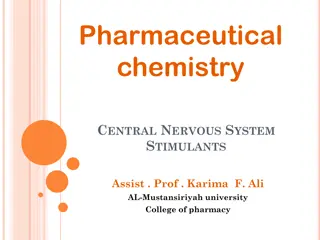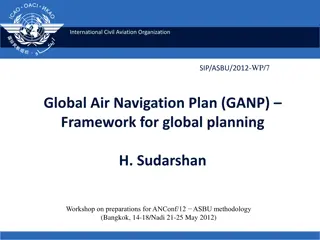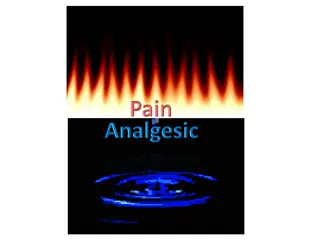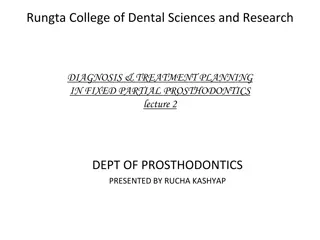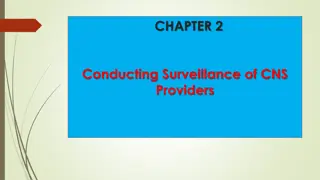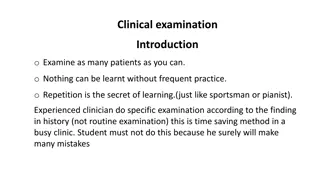Comprehensive CNS Examination Guidelines by Dr. Kiran Nandeshwar
Detailed guidelines for performing a thorough examination of the central nervous system (CNS) covering general examination, higher function assessment, Glasgow Coma Scale, cranial nerves examination, and motor system evaluation. Includes visual aids for each aspect of the examination process.
Uploaded on Sep 12, 2024 | 3 Views
Download Presentation

Please find below an Image/Link to download the presentation.
The content on the website is provided AS IS for your information and personal use only. It may not be sold, licensed, or shared on other websites without obtaining consent from the author.If you encounter any issues during the download, it is possible that the publisher has removed the file from their server.
You are allowed to download the files provided on this website for personal or commercial use, subject to the condition that they are used lawfully. All files are the property of their respective owners.
The content on the website is provided AS IS for your information and personal use only. It may not be sold, licensed, or shared on other websites without obtaining consent from the author.
E N D
Presentation Transcript
THE CNS EXAMINATION Dr. Kiran Nandeshwar
GENERAL EXAMINATION IN CNS ATTITUDE AND POSTURE OF THE PATIENT SHAPE OF HEAD BRACHYCEPHALY DOLICHOCEPHLY PLAGIOCEPHALY FACIAL DYSMORPHIC FEATURES ANTERIOR FRONTANELL POSTERIOR FRONTANELL CRANIOTABES MACEWAN S SIGN TRANSILLUMINATION OF SKULL VITAL PARAMETER
HIGHER FUNCTION LEVEL OF CONSCIOUSNESS Normal Drowsy Stupor Delirium Coma INTELEGIENCE AND MEMORY OERIENTATION OF TIME,PLACE AND PERSON DELUSION AND HALLUCINATION SPEECH Aphasia and dysarthria 1. 2. 3. 4. 5. 1.
GLASGOW COMA SCALE Eye opining (E) Verbal response (V) Motor response (M) 4. Spontaneous 5. Oriented 6. Follows command 3. To call 4. Confuse 5. Localises pain 2. To pain 3. Inappropriate word 4. Withdraws pain 1. None 2.Non specific sound 3. Flexion to pain 1. None 2. Extension to pain 1. None Total maximum score possible:- E + V + M = 15 Minimum score is 3, not zero
CRANIAL NERVES EXAMINATION
CRANIAL NERVE EXAM I - OLFACTORY DON T USE A NOXIOUS STIMULUS COFFEE, LEMON EXTRACT II - OPTIC VISUAL ACUITY VISUAL FIELDS FUNDOSCOPIC EXAM COLOUR VISION
CRANIAL NERVE EXAM III/IV/VI OCULMOTOR, TROCHLEAR, ABDUCENS PUPILLARY RESPONSE EYE MOVEMENTS 9 CARDINAL POSITIONS OBSERVE LIDS FOR PTOSIS V - TRIGEMINAL MOTOR - JAW STRENGTH SENS - ALL 3 DIVISIONS
CRANIAL NERVES VII - FACIAL OBSERVE FOR FACIAL ASYMMETRY FOREHEAD WRINKLING, EYELID CLOSURE, WHISTLE/PUCKER VIII - VESTIBULAR ACUITY RINNE, WEBER
CRANIAL NERVES IX/X - GLOSSOPHARYNGEAL, VAGUS GAG REFLEX XI - SPINAL ACCESSORY STERNOCLEIDOMASTOID M. TRAPEZIUS MUSCLE XII - HYPOGLOSSAL TONGUE STRENGTH TONGUE MOVEMENT
MOTOR SYSTEM EXAMINATION
MUSCLE POWER GRADING GRADED 0 - 5 0 - NO MOVEMENT 1 - FLICKER 2 - MOVEMENT WITH GRAVITY REMOVED 3 - MOVEMENT AGAINST GRAVITY 4 - MOVEMENT AGAINST RESISTANCE 5 - NORMAL STRENGTH
1) POSTURE OF THE LIMBS:- The child may adopt a particular posture due to change in the muscle tone 2) NUTRITION OF MUSCLE :- Assess whether the muscles are normal atrophied or hypertrophied 3) INVOLUNTARY MOMENTS:- Tremors chorea Athetosis Dystonia Hemibaliismus Myclonus Tics
4) TONE OF MUSCLE:- Test to assess tone of muscle Tests Normal Hypotonia Hypertonia Palpation of muscle Posture of limb Normal Flabby Rigid Normal Limp Stiff Resistance to passive moments Range of passive moments Normal Decreased Increased Normal Increased Decreased In Infant tone is assess by following tests:- Scarf sign, Heel to Ear manoeuvre, popliteal angle
CO-ORDINATION Gait of the patient 1) 2) Finger nose test 3) Knee heel test 4)Rhomberg s test- positive in cerebeller lesion Co-ordination can be tested only in children above 6-7 yrs when the muscle power is greater than 3
SUPERFICIAL REFLEXES Test to asses Superficial reflexes Mothod of elicitation Response 1. Planter reflex Stroke the lateral border of the sole of the foot from heel to toes. Normal response is planter flexion of all the toes 2. Abdominal reflex Stoke the skin of abdomen from the lateral end towards the midline Contraction of abdominal muscle of same side 3. Cremasteric reflex Stroke the skin of medial side of thigh from above to downwords Contraction of cremasteric muscle and elevation of testicle 4.Anal reflex Stoke the skin in the perianal region Contraction of the anal sphincter.
DEEP TENDON REFLEXES Reflexes Bicep Elicitation Tap the bicep tendon after partial flexion and pronation of the elbow Responce Flexion of the elbow and visible contraction of the biceps muscle Tricep Tap the tricep tendon just above the elbow after flexion Extension of the elbow and visible contraction of the tricep muscle Supinator Tap the bracheoradialis tendon at the lower end of radius Flexion and pronation of elbow and V.C. of the bracheoradialis muscle Knee jerk Tap the quadriceps tendon just below the knee Tap the tendoachillis after partially flexing the knee Extension of he knees visible contra. Of the quadriceps muscle Planter flexion of the ankle and V.C.of the gastrocnemius muscle Ankle jerk
DEEP TENDON REFLEX Grading of reflex:- Absent reflex 0 Sluggish reflex 1+ Normal 2+ Brisk 3+ Exaggerated with clonus 4+
DEEP TENDON REFLEX Causes of absent and brisk deep tendon reflex Absent Brisk LMN Lesion UMN Lesion Severely spastic children Tetanus or strychnine poisoning Contraction of muscle Hysteria Stage of neuronal shock In small children
SENSORY SYSTEM EXAMINATION
SENSORY EXAMINATION Superficial sensation Touch Pain Temp Deep sensation Vibration Position Cortical sensation tactile localisation Tactile discrimination steriognosis
SIGNS OF MENINGEAL IRRITATION Neck stiffness Kerning s sign Brudzinski s sign
